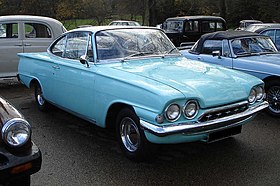Ford Consul Classic
| Ford Consul Classic | |
|---|---|

Ford Consul Classic 4 door saloon
|
|
| Overview | |
| Manufacturer | Ford |
| Also called | Ford Consul 315 (export markets) |
| Production | 1961–1963 |
| Body and chassis | |
| Class | Mid-size / Large family car (D) |
| Body style | 2-door saloon 4-door saloon |
| Related | Ford Consul Capri (335) |
| Powertrain | |
| Engine | 1.3 or 1.5 L Straight-4 |
| Dimensions | |
| Wheelbase | 99 in (2,515 mm) |
| Length | 170.75 in (4,337 mm) |
| Width | 65 in (1,651 mm) |
| Height | 56 in (1,422 mm) |
| Curb weight | 2070 pounds (940 kg) |
| Chronology | |
| Predecessor | Ford Prefect |
| Successor | Ford Corsair |
| Ford Consul Capri | |
|---|---|

1962 Ford Consul Capri
|
|
| Overview | |
| Manufacturer | Ford of Britain |
| Body and chassis | |
| Body style | 2-door coupé |
| Related | Ford Consul Classic |
| Powertrain | |
| Engine | 1340 cc I4 (OHV) 1498 cc I4 (OHV) |
| Dimensions | |
| Wheelbase | 99 in (2,515 mm) |
| Length | 170.75 in (4,337 mm) |
| Width | 65.3 in (1,659 mm) |
| Height | 54 in (1,372 mm) |
| Kerb weight | 2,100 lb (953 kg) approx |
The Ford Consul Classic is a mid-sized car that was launched in May 1961 and built by Ford UK from 1961 to 1963. It was available in two or four door saloon form, in Standard or De Luxe versions, and with floor or column gearshift. The name Ford Consul 315 was used for export markets. The Ford Consul Capri was a 2-door coupé version of the Classic, and was available from 1961 until 1964.
The 1340 cc four-cylinder engine was replaced in August 1962 by a Lotus-developed over-square 1498 cc engine with a new five-bearing crankshaft and a new gearbox with syncromesh on all four forward ratios. Steering and suspension also received "greased for life" joints.
It is sometimes referred to as the Ford 109E, though that was only one of four such codes utilized for the Consul Classic, as explained below. Obvious competitor models at the time included the Hillman Minx and Singer Gazelle from Rootes Group.
The Classic (and related Consul Capri) had the Right Hand Drive and home market Ford code of 109E (but 110E if L.H.D.) for 1961–1962 models with 1340cc engines, or 116E (but 117E for L.H.D.) for 1962–1963 manufacture with 1500cc engines. Those codes also distinguish the gearboxes and steering components which are not greasable on later cars, so cutting first-user servicing costs. Despite all these codes the cars all looked the same throughout production 1961–1963, the visual distinctions being the number of doors, the trim & equipment level between Standard and De Luxe and their exciting choice of colours.
The Classic was made by Ford to be "suitable for the golf club car park", and was originally intended for introduction earlier and deletion later than actually occurred. The styling exercises were mainly undertaken in 1956 under Colin Neale. The main styling cues came straight from Dearborn, as they so often did, defining the car as a scaled-down Galaxie 500, from the waist down, topped with a Lincoln Continental roofline. Other aspects of R&D followed, and it is likely that a recognisably similar car could have been introduced in 1959 subject to different senior management decisions. In practice the run-away early success of the Anglia (1959 on) used up most of the car manufacturing capacity at Dagenham, vindicating the decision to compete against the BMC Mini (the Halewood plant did not open until 1963). Ford therefore entered the 1960s with the small Anglia, Popular and Prefect, the big "three graces" launched back in 1956, and not the mid-size market Classic.
...
Wikipedia
